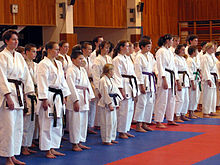Tenth dan
| Dan | |||||||||||

Dan and Kyū ranks are indicated by belt color or by stripes on the belt
|
|||||||||||
| Chinese name | |||||||||||
|---|---|---|---|---|---|---|---|---|---|---|---|
| Traditional Chinese | 段 | ||||||||||
| Simplified Chinese | 段 | ||||||||||
|
|||||||||||
| Korean name | |||||||||||
| Hangul | 단 | ||||||||||
|
|||||||||||
| Japanese name | |||||||||||
| Kanji | 段 | ||||||||||
| Hiragana | だん | ||||||||||
|
|||||||||||
The dan () ranking system is used by many Japanese organizations and Korean martial arts to indicate the level of one's ability within a certain subject matter. As a ranking system, it was originally used at a go school during the Edo period. It is now also used in modern fine arts and martial arts.
The system was applied to martial arts in Japan by Kanō Jigorō (1860–1938), the founder of judo, in 1883, and later introduced to other East Asian countries. In the modern Japanese martial arts, holders of dan ranks often wear a black belt; those of higher rank may also wear red-and-white and red belts. Dan ranks are also given for strategic board games such as go, Japanese chess (shōgi), and renju, as well as for cultural arts such as flower arrangement (ikebana), Japanese calligraphy (shodō) and tea ceremony (sadō).
The Chinese character for the word (段) literally means step or stage in Japanese, but is also used to refer to one's rank or grade, i.e., one's degree or level of expertise and knowledge. In Chinese pinyin, however, the same character is spelled duàn, and was originally used to mean phase. Dan is often used together with the word kyū (級) in certain ranking systems, with dan being used for the higher ranks and kyū being used for lower ranks.
The dan ranking system in go was devised by Hon'inbō Dōsaku (1645–1702), a professional go player in the Edo period. Prior to the invention, top-to-bottom ranking was evaluated by comparison of handicap and tended to be vague. Dosaku valued the then highest title holder, Meijin at 9 Dan. He was likely inspired by an ancient Chinese go ranking system (9 Pin Zhi) and an earlier court ranking system (nine-rank system), although lower numbers are more senior in those systems.
...
Wikipedia
